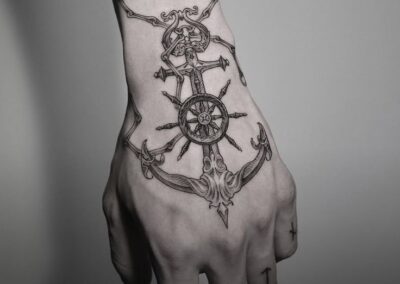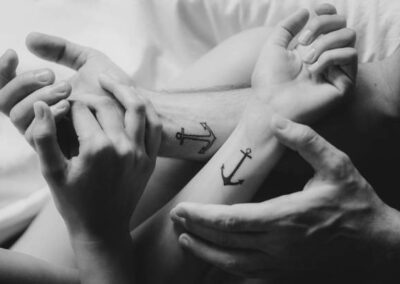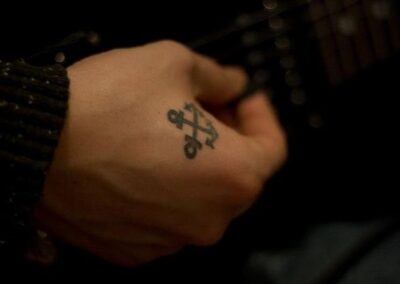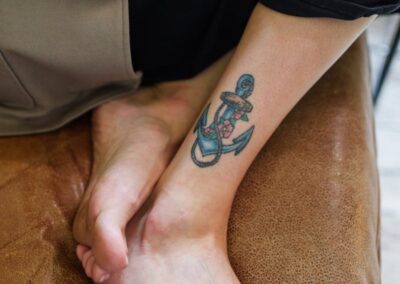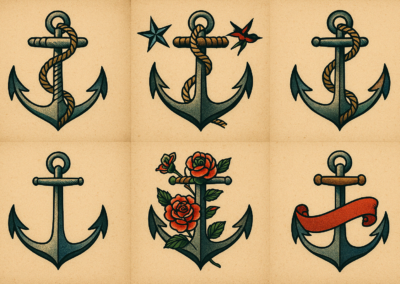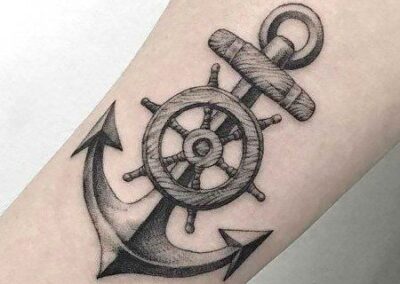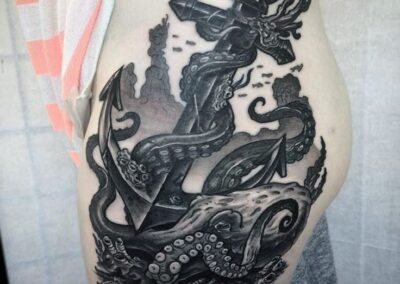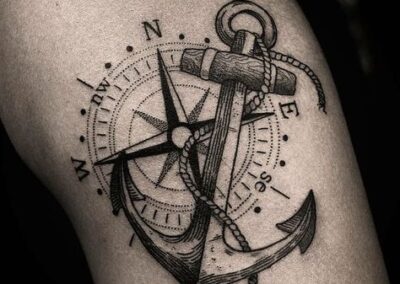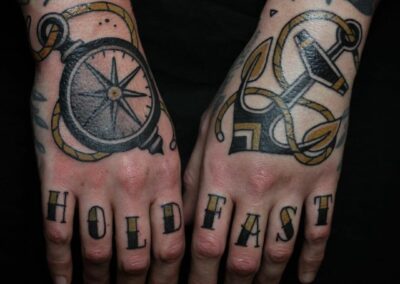The anchor has stayed relevant through centuries because it combines visual simplicity with deep symbolism. It speaks to universal human experiences: needing something to hold onto, returning home, staying firm when things get rough. In the past, anchor tattoos were earned through hardship and travel. Today, they’re chosen for similarly personal reasons, even if the person never steps on a ship. The meaning has shifted, but the symbolic weight remains.
It’s this blend of history, emotional power, and visual clarity that makes anchor tattoos popular—both then and now.
Check anchor tattoo meanings here >>
Ancient roots and early symbolism
The image of the anchor has held symbolic meaning for thousands of years, long before it became associated with tattoos. In ancient times, the anchor was linked to maritime culture not only as a practical tool but also as a symbol of safety and stability. It appeared frequently in the Greco-Roman world, both as a functional item aboard ships and as a metaphor for groundedness and hope. In Roman catacombs, for instance, anchors were carved into tombs as early Christian symbols of faith and steadfastness during persecution. They served a dual purpose: signalling religious affiliation and conveying a deeper message of spiritual grounding. For Christians, the anchor represented hope in Christ amidst turbulent times. It was discreet enough to pass as a general nautical emblem, which was critical during times of oppression.
As seafaring became central to global trade and exploration, the anchor’s symbolism broadened. Ancient mariners, who relied on stars, compasses, and anchors, saw the latter as their connection to land, a guarantee of return. For those who lived on the sea, an anchor represented home, safety, and the idea of rest after a long voyage. It carried emotional weight, especially during extended absences and dangerous passages. This period marked the beginning of the anchor’s transformation into a personal symbol – something carried or worn, and eventually tattooed, to express connection to something deeper than the surface role of sailor or merchant.
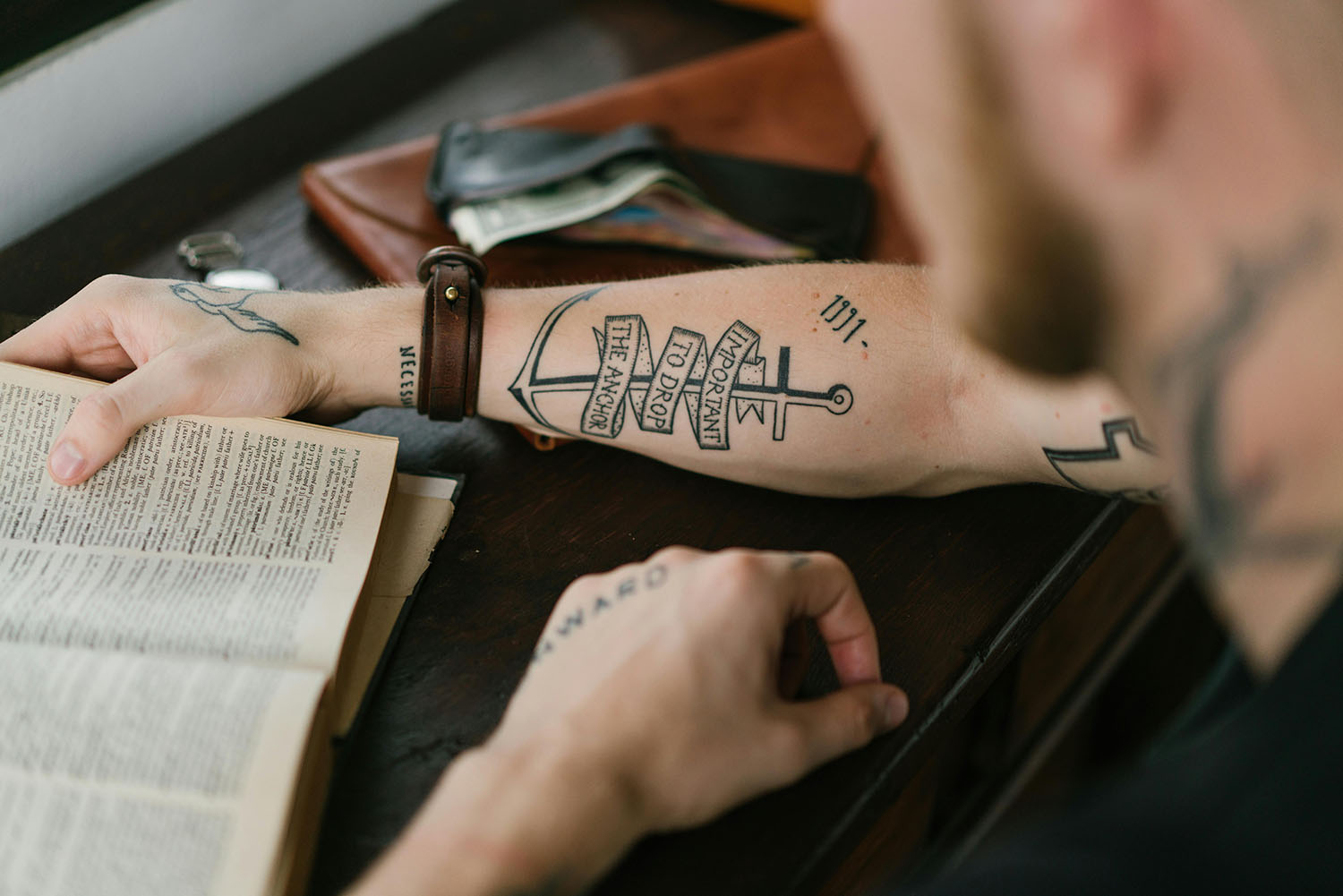
“The universality of tattooing is a curious subject for speculation…”
– Captain James Cook, Observations on Tattooing
Captain James Cook, during his 18th-century Pacific voyages, noted the widespread practice of tattooing among indigenous peoples. His observations introduced the art to European sailors, who adopted symbols like the anchor to signify their maritime journeys and experiences. (NHHC)
Naval traditions and the rise of anchor tattoos
The modern tradition of anchor tattoos stems largely from naval history, particularly in the British Royal Navy and later the American and European merchant fleets. Tattooing at sea became common in the 18th and 19th centuries, particularly after voyages to the Pacific Islands where sailors were introduced to Polynesian tattoo practices. Anchors quickly became one of the most popular motifs. They were used as personal marks of identity and pride, but also to express hard-earned status or experience. For example, British and American naval traditions held that only those who had crossed the Atlantic were entitled to wear an anchor tattoo. It was, in essence, a badge of honour.
These tattoos were typically inked by other sailors using rudimentary tools. Designs were simple but powerful: bold lines, a firm base, and a strong crossbar. Over time, additional elements were added—ropes, ships, hearts, names—to customise the message. Anchors started to mean different things to different men: a sailor’s link to his home port, his sweetheart, or his life on the sea. It was also a way to honour lost comrades, especially as tattooing became intertwined with rites of passage and remembrance.
During the First and Second World Wars, the anchor motif expanded further in popular meaning. Soldiers in the navy wore them to indicate service, but also as a token of hope they’d return. The emotional dimension of the tattoo took precedence over simple decorative value. These tattoos were now firmly woven into seafaring identity. For many, they represented belonging, both to the vast maritime world and to specific naval units or traditions. This deepened their cultural role as emblems of loyalty, duty, and endurance.
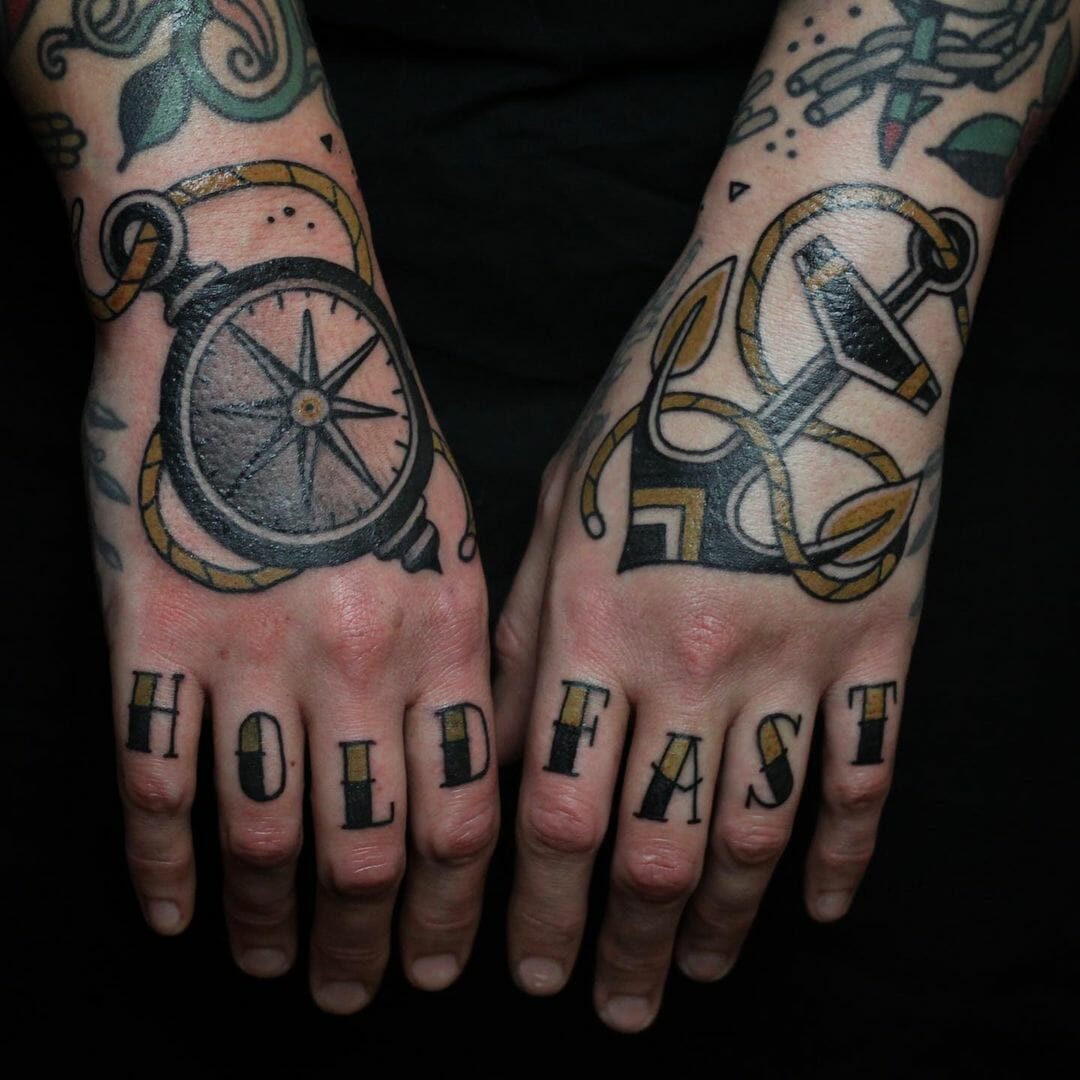
Cultural shifts and civilian adoption
By the mid-20th century, anchor tattoos began appearing beyond strictly naval circles. As tattooing became more accessible to civilians, the imagery was picked up by broader subcultures—particularly bikers, dockworkers, and blue-collar workers in port towns. For these groups, the anchor retained its association with strength and stability. In the post-war years, when many returned from military service, tattoos served as both a memento of experience and a mark of shared history. It’s during this time that anchor tattoos began to evolve beyond their original meanings, taking on more personal, spiritual, or aesthetic interpretations.
The cultural associations with anchor tattoos were also reinforced by popular media. Films, comic books, and advertisements often portrayed sailors or tough characters with visible anchor tattoos, particularly on the forearm. This helped fix the image of the anchor as a rugged, masculine symbol—though women also began adopting it, often with slight variations, to symbolise devotion, love, or perseverance. By the 1970s and 80s, the rise of Western tattoo culture saw the anchor become part of the “old school” American tattoo style, alongside hearts, roses, and eagles. Artists like Norman “Sailor Jerry” Collins developed detailed anchor designs, often surrounded by banners, swallows, or script.
During this time, tattoos in general shifted from a niche practice into a more mainstream art form. This opened the anchor up to reinterpretation by younger generations. It was no longer strictly tied to maritime life—it could now represent groundedness, emotional depth, or a personal anchor in turbulent times. The meaning diversified, but the visual remained remarkably stable. This continuity in form, combined with flexibility in meaning, helped maintain the tattoo’s relevance.
Contemporary meanings and personal symbolism
In the 21st century, anchor tattoos are seen across a wide cross-section of society. They continue to be worn by those with a direct connection to the sea—commercial seafarers, naval personnel, fishermen—but also by people far removed from maritime life. The core symbolic qualities of the anchor—strength, stability, hope, security—remain attractive to a modern audience navigating a rapidly changing world. For some, an anchor tattoo marks a personal journey: recovery from addiction, survival through hardship, or commitment to a person or purpose. It’s often used as a visual statement of values.
Designs today range from traditional, bold outlines to minimalistic or hyper-detailed illustrations. Many include accompanying words or quotes such as “I refuse to sink,” although this particular phrase has faced criticism for misrepresenting the function of a real anchor. Still, the underlying intent is consistent: anchoring oneself to something solid in times of uncertainty. The tattoo becomes a personal totem, a way to externalise internal grounding.
The anchor also resonates with spiritual or philosophical interpretations. Some see it as a symbol of faith—whether religious or secular. Others tie it to concepts of mindfulness, permanence, or identity. In a time when global mobility, digital detachment, and personal upheaval are common themes, the anchor offers a reassuring sense of rootedness. Tattooing, as a bodily practice, adds to this permanence. By embedding the symbol in the skin, the individual affirms their need for—and belief in—something that holds steady, no matter the external conditions.
Anchor tattoos are also increasingly common among women, particularly in minimalist styles. These often represent strength through adversity, emotional resilience, or independence. The gendered associations of the anchor as a masculine mark have shifted to a more inclusive understanding. Today, anyone can wear it as a personal emblem of what keeps them grounded.
“Be your own anchor. Learn to rely on yourself.” – Diane von Furstenberg

Why anchor tattoos remain popular
Anchor tattoos have remained popular over centuries because their meaning is both specific and adaptable. They started as marks of seafaring experience and belonging, especially among naval personnel. But they quickly took on broader emotional and symbolic value—representing home, hope, faith, and stability. These are fundamental human themes that resonate far beyond life at sea. In the past, they helped sailors express identity, commemorate journeys, and manage emotional distance. In the present day, they serve similar purposes—though in a world where uncertainty and change are constant, the anchor is a natural metaphor for groundedness.
Their visual form is also simple and instantly recognisable. This helps the symbol survive trends and remain a timeless choice in tattoo culture. Whether rendered in a traditional bold style or a fine-line minimalist approach, the anchor still says something clear about the person wearing it. It offers a sense of continuity in a fast-moving world. That’s why they were popular then, and why they still are now.
Anchor tattoo meanings
⚓ Maritime and Nautical Meanings
-
Safety – Anchors represent physical and emotional security at sea.
-
Homecoming – A symbol of return, connection to one’s home port or family.
-
Seafaring Identity – Often used by sailors and mariners to express life at sea.
-
Experience – Traditionally marked major journeys (e.g. Atlantic crossing).
-
Naval Service – Used to signify duty in the navy or merchant marine.
💬 Emotional and Personal Meanings
-
Stability – Represents grounding and mental steadiness through life’s storms.
-
Resilience – Symbolises strength during hardship or recovery.
-
Hope – Often tied to the Biblical phrase “hope as an anchor for the soul.”
-
Commitment – Emblem of loyalty to a person, cause, or belief.
-
Endurance – Associated with weathering difficult times and emerging stronger.
🛐 Spiritual and Religious Meanings
-
Faith – Especially in early Christianity, the anchor was a symbol of Christ and salvation.
-
Protection – Considered a spiritual safeguard during dangerous journeys.
-
Inner Peace – Represents a calm centre within chaos or uncertainty.
💞 Love and Relationships
-
Devotion – Anchor tattoos with initials or hearts often signify lasting love.
-
Trust – Seen as a metaphor for being someone’s safe harbour.
-
Permanence – Symbolises unwavering affection or lifelong bonds.
🧭 Modern Interpretations
-
Self-reliance – “Be your own anchor” has become a common motivational phrase.
-
Minimalism – Clean, modern anchor tattoos appeal for their visual simplicity.
-
Identity – A popular symbol of one’s values: strength, depth, loyalty.
Sources and further reading
- Caplan, J. (2000). Written on the Body: The Tattoo in European and American History. Princeton University Press.
- DeMello, M. (2007). Encyclopedia of Body Adornment. ABC-CLIO. Sanders, C. R. (2008). Customizing the Body: The Art and Culture of Tattooing. Temple University Press.
- Pitts-Taylor, V. (2003). In the Flesh: The Cultural Politics of Body Modification. Palgrave Macmillan.
- Govenar, A. (2000). The Changing Image of Tattooing in American Culture, 1846–1966. Journal of American Culture, 22(3), 53–62.
- Rubin, A. (1988). Marks of Civilization: Artistic Transformations of the Human Body. Museum of Cultural History, UCLA.
- Morris, D. (1997). Bodywatching: A Field Guide to the Human Species. Vintage.

